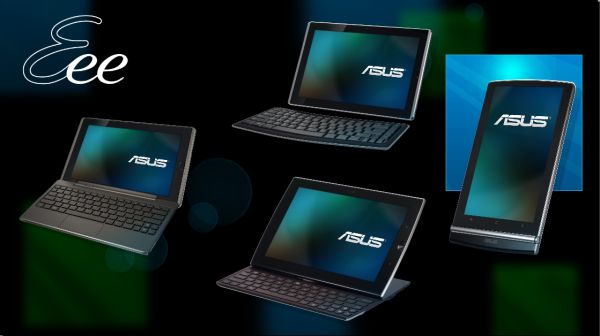ASUS Announces Eee Pad and Eee Slate Tablets
by Vivek Gowri on January 4, 2011 5:42 PM ESTASUS Tablets—Introduction
With CES 2011 upon us, we must acknowledge that 2011 could well be the “Year of the Tablet”. Everyone—Motorola, Dell, HP, HTC, Acer, you name it—is releasing a tablet or three. If you’re ASUS, you’re announcing four different tablets today. If you are ASUS, I’d like to offer my congratulations and best wishes for this full-on assault of the tablet market. Chances are though, you’re not ASUS, so here’s the rundown on the four new devices.
Three of them are Honeycomb-based tablets, joined by a traditional Windows slate. Looking at the Android tablets, we have the MeMO, a 7” Snapdragon slate, the Transformer, a 10” Tegra 2 slate with an optional keyboard docking station (hence the name), and the Slider, an interesting 10” model with a sliding, tilting keyboard (think a supersized HTC Touch Pro 2). All three of these come under Eee Pad branding, while the Windows tablet is branded as the Eee Slate EP121. It’s a 12.1” slate with an active Wacom digitizer and Core i5 UM power. There are IPS displays and 178 degree viewing angles to go around, as well as 1080p playback and HDMI outputs.
Like I mentioned before, ASUS is just one company in a huge wave of forthcoming tablets. After Apple, Google is the biggest player in the room, both in the form of existing Froyo devices like the Galaxy Tab and new systems based on Honeycomb. Microsoft, who really made the first tablet push back in 2003, are still there, but seeing themselves being reduced to a bit player until something drastic changes (is anyone else seeing the parallels with Windows Mobile here?) BlackBerry and HP/Palm are hoping to make a splash with the PlayBook and WebOS, respectively. Given all these different players, let’s break down the four new ASUS tablets further.

















37 Comments
View All Comments
vol7ron - Tuesday, January 4, 2011 - link
As with all things computing, the success hinders on options and price. They have to give enough of the former and reduce enough of the later.True belief: pad/netbook devices need a smaller profit margin.
michael2k - Tuesday, January 4, 2011 - link
The high profit margin is the only reason that anyone is entering the market. Without the high profit margin, no one would introduce a single, let alone four, products.Let the early adopters pay the high margin if that is what concerns you.
MobiusStrip - Wednesday, January 5, 2011 - link
GPS. EVERY tablet should have GPS. Tablets are little more than a gimmick, but the addition of GPS would add solid value at very little cost to the manufacturer. Not to mention beating Apple, which irritatingly omitted GPS from half the iPads.Any vendor that fails to take this obvious step doesn't deserve your dollars, and their products aren't going to be around long anyway.
tipoo - Tuesday, January 4, 2011 - link
On the spec sheet next to battery life they probably just write "No".JarredWalton - Tuesday, January 4, 2011 - link
Except we got pretty good battery life from the ASUS U30Jc, and the UL80Jt, and.... It will depend on how big the battery is, but the i5-470UM ought to be able to hit at least five hours on a ~30Wh battery.VivekGowri - Tuesday, January 4, 2011 - link
Yeah, they didn't actually mention battery life, indicating that it's probably not very good.....Unfortunate, but it's a reality. I think Windows slates are going to be doomed to mediocre battery life - Intel chips aren't low-power enough for tablets (yet). That'll change with Moorestown and Oak Trail, but right now they just can't compete with ARM as far as handheld battery life.halcyon - Wednesday, January 5, 2011 - link
Well, Asus pretty much wrote "no" in the specs of Eee Slate EP121:Battery life: up to 3 hours (under specific conditions, which you can easily guess what those are)
In real life usage that is going to mean less than 2 hours of battery life.
If that is not a FAIL for a tablet, I don't know what is.
tipoo - Wednesday, January 5, 2011 - link
Yeah, three hours is what I would consider bad in a laptop, let alone a tablet.headbox - Tuesday, January 4, 2011 - link
I predict Zune-like sales if they're lucky.bplewis24 - Tuesday, January 4, 2011 - link
Anybody else find it interesting that Asus is going with IPS displays across the board here when they generally do not use IPS displays in their mainstream desktop monitor line of products?Does this signify a shift in focus that will carry over to their desktop monitors or will it be exclusive to their tablet/slate product line?
Brandon